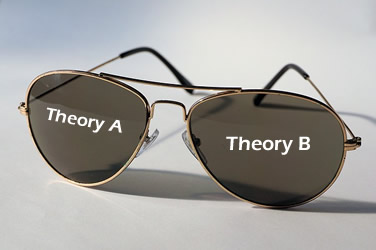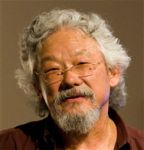Social Change
Theories and Activists
MINDS ON
“
Theorists have wonderful ideas which take years and years to be verified.
~ David Gross
In much the same way as different social science disciplines view the same issue through their own unique lenses, the specific theories within a social science can be used to describe different patterns or outcomes that occur. A specific change event can be studied or explained by utilizing a variety of theories. This does not mean that one theory is more or less correct than another, but they can be more strongly or weakly connected to a particular example. As well, they each lead to different insights and explanations of the event.

In future activities, as well as with the culminating task, you will be asked to apply these theories to instances of social change. A good understanding of these theories, therefore, will help you succeed in this course.
ACTION
Social Science Theories
In the learning object below, you will find summaries of a number of different social science theories, along with videos to view and links to visit for more information. You are also encouraged to do additional research on your own to further your knowledge of these theories.
SocialChangeTheories
When you compare all of the theories mentioned above, some may seem to be closely related to each other and some may seem quite different. While each of these social science theories can ultimately be attributed to the person who first proposed them (in some cases more than a hundred years ago), other researchers have applied them, as well. They utilized the basic tenants of one theory and adapted or modified it. As the quotation from Gross at the top of the page suggests, it takes years to prove or disprove a theory.
 Theories Explained
Theories Explained
After you have worked through the information provided, your task is to explain how each of these theories helps to explain events of change. This could be either a positive relationship in that they encourage change to occur, or a negative one in that they explain resistance to change. Compile your thoughts in a report, a chart, or a mind map style of your choice. You can use any mind mapping tool of your choice. You could even draw one!
Activists – People Making Change
In Unit 1, Activity 3, we saw that behind each social movement is an individual or group of individuals who started with a problem they were passionate about fixing.
It is important to remember that there are many contemporary activists(definition:People who take action to effect social change.) utilizing the principles of these theories to further their work. You have already seen the names of activists in previous lessons, and will see many more throughout the course. Below is one such example.
David Suzuki is a Canadian who has instigated large-scale social change. Many people view him as an environmentalist because his work has been centered on the awareness of environmental degradation. However, at the same time that he promotes awareness, he also presents ways that people can lessen their environmental impact on the planet around them. Many examples of these strategies are available on the David Suzuki Foundation website.

 Questions
Questions
- Which theories could be applied to Suzuki's work?
AnswerWhile there are certainly other options, these theories are simply meant to provide a starting point in understanding how theories can be applied to the work of activists.
Cultural Materialism – It is also important to understand the connection that may exist between consumerism and consumption and environmental degradation. Because of the vast difference between North American and/or European lifestyles as compared to cultures with much less consumerism or even those who live subsistence lifestyles, through a cultural materialism lens we must consider Suzuki's message as it applies to these different audiences. Read about Suzuki’s views on the Consumer Society.
Cognitive Theory – The government has, in many ways, come to support environmental causes. In the 1990's, recucyling programs were being introduced across Canada, and more recently green bin programs have launched in many communities. At the same time, in many locations citizens are charged a fee per bag for garbage disposal often by the bag through a sticker program or directly in their municipal taxes. With their actions, the government has created a situation where residents are essentially being punished for neglectful environmental behaviour but at the same time guided into making responsible choices.
Research Skills
All social science courses require an understanding of proper research techniques; a working knowledge of how to refer in academic writing is also important.

Referring is, in its simplest form, giving credit for the ideas of others that you have used in your writing. On the opposite end of the spectrum is plagiarism: gathering ideas through research and not stating that they were found in another source. This can be grounds for academic penalty by way of reduced marks on the plagiarized assignment or, in extreme circumstances, failure to achieve the credit.
Plagiarism
Plagiarism can take place in two ways – researching work and not providing the source, or submitting work that is identical or overly similar to that of a classmate, someone who has taken the course before, or even work that you have previously submitted in another course. Remember also that while plagiarism is typically thought of as copying another source word for word, it can also involve taking another's ideas and rewording them just enough to make them appear to be your own work. To be sure that you understand plagiarism, you can find more information on the OntarioTech Library website.

Originality Checks
Many teachers employ originality checks such as TurnItIn, which compares the work you have submitted against Internet and print sources, as well as against the work submitted by other students. Look at this as a learning experience. By analysing any instances of plagiarism that the software has identified, you can learn what you need to do differently when you refer to prevent this in the future.
Referencing versus Citing

These terms are sometimes used interchangeably; however, this is not quite correct. While they are both important components of academic writing, they are not the same thing. Citing your work refers to an in-text note in the form of a bracket with the minimum amount of information necessary to help the reader locate the source of the information on your reference list.
For both citations and references, there is a very strict format to follow. In this course, we will use the APA Citation format (American Psychological Association). However, you might have learned how to use the MLA or Chicago format in other courses. Certain academic disciplines tend to prefer one format over another as their standard.
|
Usage |
Description |
Example |
|---|---|---|
|
Direct Quotation |
The information has been used word for word from the original source that was cited in the work. This type of quotation can be identified because of the use of quotation marks. |
There was a study done with a Gr. 8 classroom which determined that “the favourite topping, by almost 70% of the vote, was pepperoni” (Miller, 2016). |
|
Indirect of Paraphrased Quotation |
The information has been taken from the original source, but the words have been changed. No quotation marks are used. |
There was a study done in a Gr. 8 classroom which determined that by a wide margin, most students would still say that pepperoni is their favourite topping on a pizza (Miller, 2016). |
Note that in both examples credit is given in the citation. There are a number of exceptions and variations to this format which are explained in detail in the resources below.
Both of these sentences would require that an entry be created in the Reference List of the work because the source was used for information. You would not be able to determine from the reference list whether it was incorporated as a direct or indirect quotation. It would appear as follows:
Miller, S. (2016). Pizza Obsession. Retrieved from http://fictionalpizzaresearch.com
NOTE: fictionalpizzaresearch.com is not a live website.
If you find citing and referencing difficult, do not worry. This is not something you have to memorize. Rather, you need to understand why and how to do it properly. There are a number of great online resources that help explain the structure and provide examples, as well as some websites that will help you compile and properly format your work for no cost.
 Additional Information on Citations and References
Additional Information on Citations and References
- Examples and explanations of various formats for references and citations:
- OWL Purdue Online Writing Lab
- Queen's University Guide to Citing Sources
- Websites that will help you create citations and reference lists:
CONSOLIDATION
 Current Change Event
Current Change Event
Earlier in this activity, you were asked to determine how each of the theories related to or helped to explain change. You will now apply your learning to a current event of change.
Looking at any change event that is currently in the news, apply two of these theories and analyse how each perspective would explain the cause, need for, or result of this change. You can find change in many news stories, but examples might include a specific political change, environmental regulation, or social issue.
Your work should contain the following elements:
- a summary paragraph that informs the reader about the change event that you have selected;
- two paragraphs (one for each theory that you have selected) to outline how it might explain this specific event; and
- a statement indicating which of the two theories you feel is a better fit when viewing this change event. Justify your selection.
Use at least two different news sources to learn about your current change event. Make sure you provide proper citations for these sources throughout your written assignment. Try to utilize both direct and indirect quotations in your writing. At the end of the assignment, include an APA formatted reference list. Remember to be wary of any bias that might be contained in the sources you select in order to evaluate whether you believe they are worthy of inclusion.
The content of this lesson has covered two major cornerstones of social science – the theoretical perspectives through which social scientists both study and understand the world around them, as well as the purpose for, and the mechanics of, APA referencing. Both of these topics will reoccur throughout the course; you will also revisit them in other social science courses that you may take at the secondary or post-secondary level.